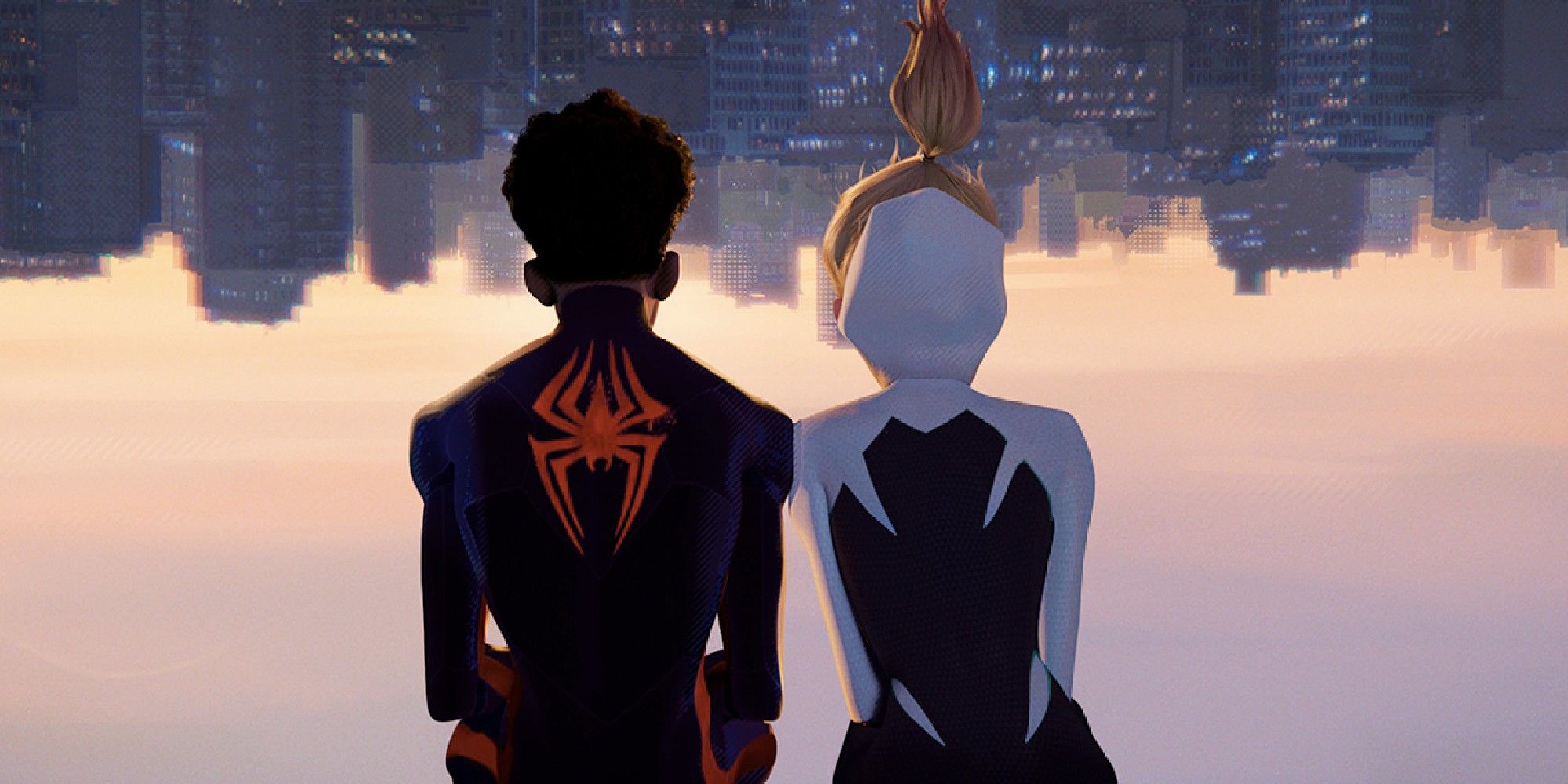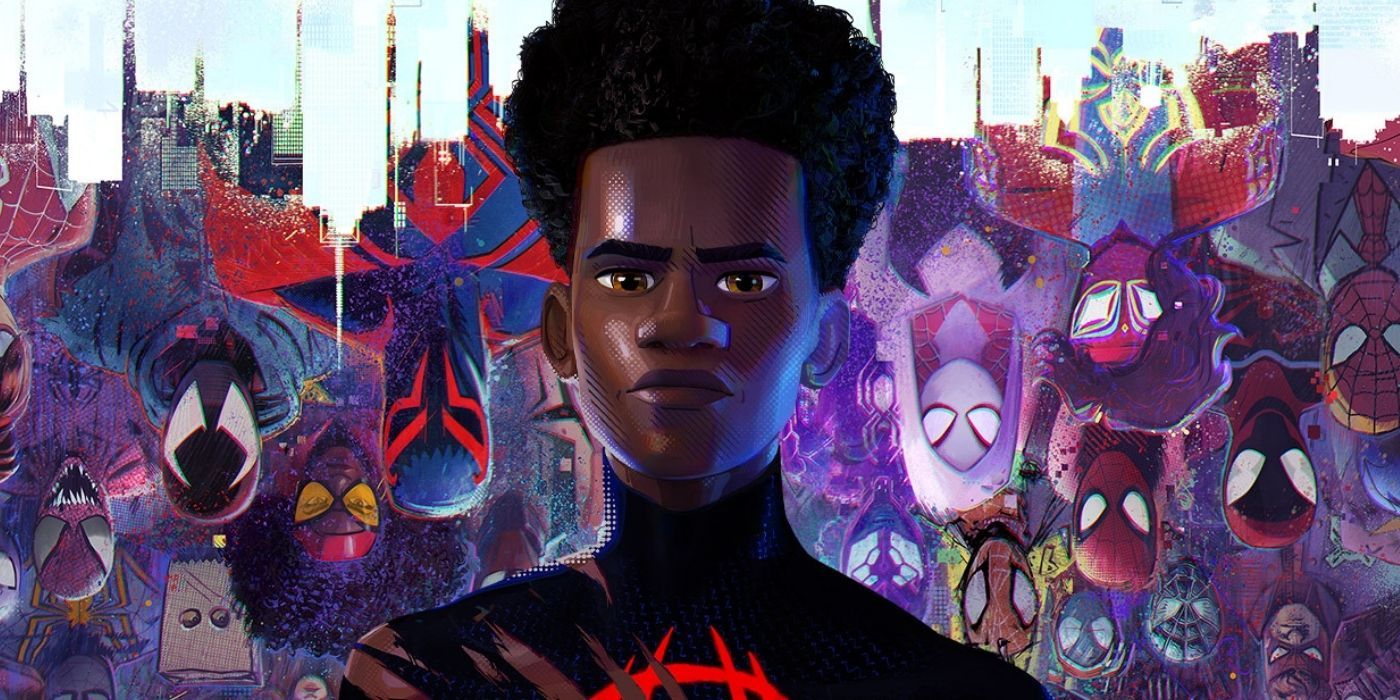“Let’s do things differently this time,” Gwen Stacy (voiced by Hailee Steinfeld) says in the opening moments of Spider-Man: Across the Spider-Verse. That seems to be the mantra of the Spider-Verse series, which began with 2018’s Spider-Man: Into the Spider-Verse, a film that combated the audience’s exhaustion with Spider-Man movies and Spider-Men by…introducing more Spider-Characters than ever. Into the Spider-Verse was a breath of fresh air for Spider-Man films, one that introduced the world to the multiverse and earned an Oscar for Best Animated Feature. After Tobey Maguire and Andrew Garfield’s Peter Parkers, it was Miles Morales (Shameik Moore) who showed us just how vibrant and full of possibilities Spider-Man could still be.
Five years later, we return to the Spider-Verse and Miles Morales again. And while the stakes have never been higher for Miles, the same is true of this series, which has the task of trying to follow up what many consider to be one of the best animated films in recent history, one of the best superhero films ever, and a film that already seems to have influenced entertainment in major ways, from the style of films and TV like Puss in Boots: The Last Wish and Ms. Marvel, to showing the potential of this hero that Spider-Man: No Way Home followed up on. Into the Spider-Verse is a modern-day classic, and yet, Across the Spider-Verse somehow manages to equal—if not improve—upon this incredible world. With even more striking animation, a more powerful connection to its characters and their relationships, it is one of the most engaging, exciting, and jaw-dropping films to come out in years. By the end of Across the Spider-Verse, the question of who is the best cinematic Spider-Man has been answered: it’s Miles Morales. But not only that, this very well might be the best superhero movie series so far.
'Across the Spider-Verse' Is a Web of Possibilities
Across the Spider-Verse takes place a little over a year after the events of Into the Spider-Verse. Gwen has left her own universe to join a group of other Spider-People who are traversing other universes in order to close the tears created by the collider in Into the Spider-Verse that are still causing anomalies. Meanwhile, in his own universe, Miles Morales has grown into his newfound abilities quite well but, as is the case with all Spider-Men, is having trouble balancing the life of his alter-ego and his real life, which also keeps his mother Rio (Luna Lauren Vélez) and father Jefferson Davis (Brian Tyree Henry) at a distance. Miles also misses his Spider-Friends—especially Gwen—who haven’t visited him since their last adventure. Making things even more difficult for Miles is the new villain The Spot (Jason Schwartzman), who claims to be Miles’ nemesis, and has discovered how to explore other universes through his holes (His power is holes he can use as portals. C’mon, grow up).
But once Gwen does visit Miles, he learns that there’s an entire Spider-Society, led by Miguel O’Hara/Spider-Man 2099 (Oscar Isaac), who are trying to keep the multiverses as they should be—including trying to stop The Spot. Miguel has seen what happens when events don’t go as they should, and dedicates himself to making sure the Spider-Verse is as it should be. But when Miles discovers what that means for him and his existence as a hero, he could be going against the very core tenants of what makes a Spider-Man.
With great multiverse-exploring abilities comes a great amount of new characters, such as Spider-Woman (Issa Rae), who assists Miguel and the Spider-Society in their attempt to fix the multiverses; Pavitr Prabhakar (Karan Soni), the Spider-Man of Mumbattan—a combination Mumbai/Manhattan; Spider-Punk (Daniel Kaluuya), who uses his guitar in fights and doesn’t follow authority; and plenty more Spider-People than you could count. Yet despite just how much Across the Spider-Verse is throwing at the audience (and it is a lot), directors Joaquim Dos Santos, Kemp Powers, and Justin K. Thompson, as well as writers Phil Lord, Christopher Miller, and David Callaham, somehow are able to balance all of these new characters and opportunities in a way that is never overwhelming. They've made a world that is always compelling to get lost in.
'Across the Spider-Verse' Blends Styles and Tones With Ease
In addition to this impressive balance of characters is the unbelievable amount of worlds that Across the Spider-Verse throws the audience into, each with its own animation style and tone, all of which could likely maintain their own standalone film. The possibilities here are literally endless, as we see worlds like the futuristic Spider-Man 2099 universe, a world that looks even more like a comic book, and even a Lego world, just to name a few. Each universe is captivating in its own way, and the way Across the Spider-Verse seamlessly intertwines all these inventive concepts together in a way that makes narrative sense is appallingly brilliant.
Even better is how these unique characters and gorgeous worlds play with each other. In the intro which focuses on Gwen Stacy, we see her world is full of pastel colors, with pinks and purples and neons that pop. She is faced with a version of the Vulture from another multiverse that is Renaissance-themed, and the villain seems to be made of paper. Or as The Spot gets stronger, his black-and-white look gets rougher and rawer, cutting through the stunning environments that he finds himself in. It’s fascinating to watch how these two styles play with each other, and the film constantly is mashing up techniques in this way, whether with a quartet of Spider-People from different realities, or literally hundreds in an action sequence.
But these unique art techniques aren’t just the directors and animators flexing on audiences—although each shot could be printed and framed on a wall—it also helps explore the story in extraordinary ways. In one scene, Gwen has an emotional conversation with her father George Stacy (Shea Whigham), and as the two talk, the world around them shifts and changes. The style is borderline impressionistic, and as their tones change and realizations come to life, the color drains from this world and returns as the conversation ebbs and flows. Yet this approach isn’t distracting. Rather, it feels like the narrative informing the art and world around them, giving us a deeper insight into how they’re feeling—similar to how comics use thought bubbles to explore internal emotions. Across the Spider-Verse is full of ingenious touches like this, and the care and love for this story are truly felt in every frame.
'Across the Spider-Verse' Builds On and Improve Upon 'Into the Spider-Verse'
Across the Spider-Verse, however, is certainly not all style and no substance, as Lord, Miller, and Callaham have crafted a story that ups the ante on all of Miles Morales’ problems. His relationship with his family is more fractured and complicated, now that he’s accepted the responsibilities of Spider-Man, yet he’s still trying to figure out how to approach this mantle that he’s been given. He misses his friends, and feels left out in a community that existed without his knowledge. And he’s worried that the people he loves the most are going to be hurt simply because of who he is. While Into the Spider-Verse ended with Miles stating that anyone could wear the mask, Across the Spider-Verse complicates that, asking if that could be true, and even confronting in a very meta way what it even means to be a Spider-Man at its essence. Across the Spider-Verse manages to make this last question a major struggle that Miles has to explore, but the film also has a lot of fun diving into our collective knowledge of the Spider-Man canon and tossing in major Easter eggs and incredible jokes for the casual and die-hard Spider-Man fans to catch.
Considering how Into the Spider-Verse felt like a shot of adrenaline into Spider-Man, it seemed almost impossible that Across the Spider-Verse could live up to the lofty expectations that this follow-up inherently had. Yet, somehow, Across the Spider-Verse cranks everything Into the Spider-Verse did well up to 11, making this another refreshing jolt to this character and superhero films in general. Across the Spider-Verse isn't just easily one of the best films of 2023 and one of the best animated films in years, it's also in the running for best superhero film ever, and arguably cements Miles Morales as the best Spider-Man we've seen on the screen so far. Across the Spider-Verse is ambitious and remarkable to a point that it almost feels like a miracle this movie even exists—thankfully, we live in the universe where it does.
Rating: A
Spider-Man: Into the Spider-Verse comes to theaters on June 2.



Comments
Post a Comment